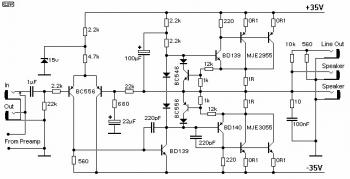The speaker and line out connections allow up to two 8 Ohm speaker cabinets (giving 4 Ohms), and a line level output for connection to a direct injection (DI) box. The level is about 1.3V (or +5dBm) at full undistorted output - change the 560 Ohm resistor to modify the level if desired.
The two 1 Ohm resistors must be rated at 10 Watts (they will still get quite hot, so mount them well away from other components). These can be mounted to the heatsink with small brackets if you want to keep them a bit cooler - remember to ensure that the heatsink can handle the extra heat input, as these two will add about 10 Watts of additional heat energy. The four 0.1 Ohm resistors should be 5W types. The amp is otherwise quite conventional. Use the parallel arrangement as shown, anything less will cause the transistors to be operated outside their safe operating area, which will result in the eventual failure of the output stage.
Make sure that the two bias diodes are mounted well clear of anything that gets hot - including the heatsink. These diodes are the two in series. All diodes should be 1N4001 (or 1N400? - anything in the 1N400x range is fine). A heatsink is not needed for any of the driver transistors.
The life of a guitar amplifier is a hard one, and I suggest that you use the largest heatsink you can afford, since it is very common to have elevated temperatures on stage (mainly due to all the lighting), and this reduces the safety margin that normally applies for domestic equipment. The heatsink should be rated at 0.5 degree C/Watt to allow for worst case long term operation at up to 40 degrees C (this is not uncommon on stage).
Make sure that the speaker connectors are isolated from the chassis, to keep the integrity of the earth isolation components in the power supply.
About Audio Amplifier
An audio amplifier is an electronic amplifier that amplifies low-power audio signals (signals composed primarily of frequencies between 20 - 20 000 Hz, the human range of hearing) to a level suitable for driving loudspeakers and is the final stage in a typical audio playback chain.
The preceding stages in such a chain are low power audio amplifiers which perform tasks like pre-amplification, equalization, tone control, mixing/effects, or audio sources like record players, CD players, and cassette players. Most audio amplifiers require these low-level inputs to adhere to line levels.
While the input signal to an audio amplifier may measure only a few hundred microwatts, its output may be tens, hundreds, or thousands of watts. More explanation about power audio amplifier can be found at wikipedia.org
An audio amplifier is an electronic amplifier that amplifies low-power audio signals (signals composed primarily of frequencies between 20 - 20 000 Hz, the human range of hearing) to a level suitable for driving loudspeakers and is the final stage in a typical audio playback chain.
The preceding stages in such a chain are low power audio amplifiers which perform tasks like pre-amplification, equalization, tone control, mixing/effects, or audio sources like record players, CD players, and cassette players. Most audio amplifiers require these low-level inputs to adhere to line levels.
While the input signal to an audio amplifier may measure only a few hundred microwatts, its output may be tens, hundreds, or thousands of watts. More explanation about power audio amplifier can be found at wikipedia.org
This is a video tutorial about how to a very simple audio amplifier based on the LM386 amplifier chip. It can be built for less than $20 (or might be less than $8 in some countries) and used to amplify any low level audio signal including a guitar, bass or mp3 player.
Watch the video:

No comments:
Post a Comment